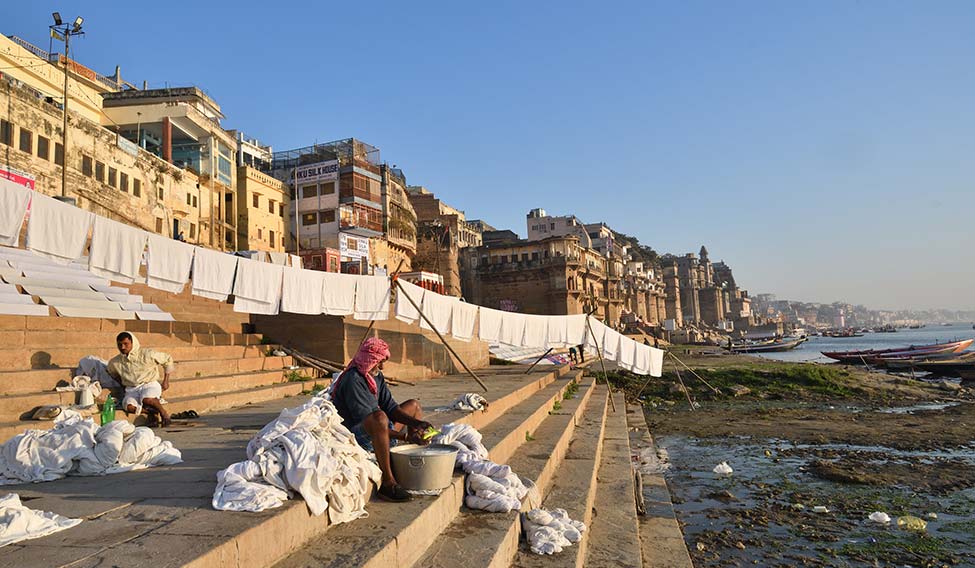It is six in the evening. At the Dashashwamedh Ghat in Varanasi, there is a continuous stream of people taking a dip in the river Ganga and looking for a place on the steps to watch the aarti. Many people buy vantage positions offered by boatmen to watch the hour-long spectacle from their anchored vessels. The ritual got a renewed push after Prime Minister Narendra Modi performed the aarti following his victory from the constituency in 2014, and brought his Japanese counterpart, Shinzo Abe, the following year, to witness it.
Choosing Varanasi to make his Lok Sabha debut, Modi portrayed himself as an unabashed Hindu nationalist, which proved to be beneficial for the BJP in the polls. Three years later, the BJP’s campaign in Uttar Pradesh assembly elections has gathered strong overtones of religious polarisation—as speeches veered towards ‘shamshan and kabristan,’ and electricity on ‘Ramadan and Diwali’—and it is expected to become more strident when the assembly constituencies in Varanasi, which has a significant Muslim population, go to the polls on March 8. The holy city is gearing up for two roadshows, one by Modi and BJP president Amit Shah and the other by Chief Minister Akhilesh Yadav and Congress vice president Rahul Gandhi.
A victory in Varanasi is a prestige issue for the BJP. Midway through the elections, party bigwigs, starting with Shah, shifted their base to Varanasi. Union Health Minister J.P. Nadda was made in charge of Varanasi, which has five assembly seats. Several other Union ministers, including Piyush Goyal, Smriti Irani, Manoj Sinha, Mahendra Pandey, are criss-crossing the nooks and corners of the state to remind the voters of the work done by Modi. RSS volunteers, too, are reaching out to the electorate to ensure that the BJP not only retains its three seats in Varanasi, but also wrests the other two.
Both the locals and the visitors agree that cleanliness on the 80 ghats of Varanasi has certainly improved. “The ghats have transformed after Modi got elected,” says Santosh Biswas, who sells lemon tea at Assi Ghat. “The city is getting a lot of projects. Tourists and visitors are happy now. It is good for business.”
Of late, Varanasi has been witnessing a lot of activities, with highways and ring roads being built, both by the Centre and the state government. The Modi government is restoring temples and cleaning sacred ponds through the urban development ministry’s HRIDAY scheme.
But the city has not grown the way it should have and the BJP blames the Samajwadi Party government for it. “The state government is working against the development works started by the Centre,” says Ravindra Jaiswal, BJP MLA from Varanasi North, who is seeking re-election. “Modi has given a lot of gifts to Varanasi. Whatever work is sanctioned, the state government puts a spanner in the works.”
However, the BJP has devised a way to overcome the roadblocks. It has formed a ‘mini PMO’ to address the problems of the constituency. Led by RSS activist Shivsharan Pathak, the team notes down the complaints and sends them to the departments concerned with a covering letter. Most of the times, a simple phone call does the trick, claims Pathak.
The undercurrent of discussions remains Modi’s image of a strong Hindu leader. “The welfare of India depends on the growth and strength of Hinduism,” says O.P. Kejariwal, former Prasar Bharati CEO and former director of Nehru Memorial Library. “I am happy with what Modi is doing to promote Hinduism for a safer and better life. Varanasi is showing the way forward.”
The BJP candidates are confident that the Modi wave would work this time, too. However, a lot depends on the Muslim voters who could shift the balance if they vote en masse for either the SP or the BSP. Modi’s demonetisation drive could also have a negative effect. “Everyone has been affected by the note ban,” says Raja Bhai, a Muslim weaver. “The Samajwadi Party and the Congress pairing is like that of Ram and Lakshman.”
Half-hearted embrace
Jayapur got the status of a VIP village after Modi adopted it in 2015 under the Sansad Adarsh Gram Yojna. Two years later, the village boasts concrete roads, a skill development centre and bus stop with free WiFi, a luxury for the region that faces acute power shortage. Every house has a new toilet. The streets have solar-powered lights, there is a post office and national banks have opened branches there.
On the surface, Modi seems to have taken good care of his people, but scratch a bit deeper and problems slowly begin to surface. “The villagers need more jobs,” says Rajendra Patel, a resident. The facilities given by the Central government have begun to show signs of strain after Modi adopted another village, Nagepur.
“Toilets have been built, but there is no sewerage or water,” says another resident. Many people have gone back to the old ways. After our village was given a VIP treatment, it attracted a lot of jealousy. Batteries of most of the solar street lights were stolen.”
Nagepur, however, is yet to show any signs of development. The weavers in the village are hoping for a turnaround as their livelihood is under threat because of poor returns. “We are living a hand-to-mouth existence. We take one week to weave a sari and sell it for 01,200, which is sold by the middlemen for a good profit,” says Budhu Ram. “It is later sold for several thousands of rupees in Delhi.”






